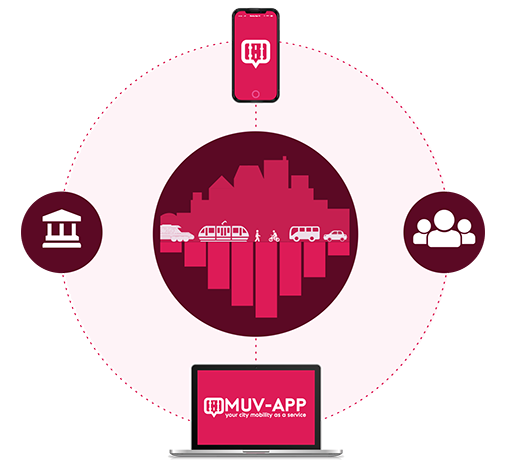MUV-APP is the platform that turns the complex and huge urban mobility system into a safe, sustainable and user-friendly system. MUV-APP enables Mobility as a service for the public administration, to provide innovative tools for the management of the entire urban mobility system.
MUV platform is a Smart Mobility Management System designed to serve both end-users of the urban mobility market and public administrators. In other words, MUV is a holistic App since it not only delivers information on demand but also provides a more comprehensive platform throughout all the aspects of urban mobility. From this configuration, the MUV architecture is divided into two main sectors: one for the final user and the other one for all the officers in charge of the mobility management. For each of these two broad sectors, there are different modules.
The modules aimed at serving the mobility users are called:
City-Glance's main aim is to reduce both mobility actors’ and services' fragmentation. While, on the one hand, users need reliable and effective support to make their mobility choice, on the other hand, this same situation hinders public administrators to obtain a comprehensive overview of their local mobility market. In other words, while users need reliable and effective support to make their mobility choices, local authorities and mobility agencies (our References/Customers) need an efficient support system able to describe what really happens between the mobility offer and demand. Thus, the main goal of the City-Glance module is, on the one hand, to create a reliable single point of access for the users, and, on the other hand, to provide Municipalities with a clear overview of all the aspects occurring in the city.
The second module, City-Loop module’s main focus is to enrich the experience of every mobility user (commuter, usual traveler, family cruiser, etc). Once the user is registered to the platform, MUV starts acting as a sort of concierge mode service provider. This module treats all mobility users as true References/Customers. In fact, if Cities want to achieve real smart mobility, then focusing on users is of fundamental importance. In other words, the assumption at the basis of the City-Loop module is that every mobility user should be treated like a real customer of the whole urban market, and the satisfaction of those References/Customers should be the central aim of the Public Administrators in charge of the mobility management.
The third module, the City-Zen module is composed of features aimed at engaging and empowering users’ mobility in the urban area. Thanks to the City-Zen module every registered user can send feedback about the status of the mobility (traffic jam, busy bus, etc.). Every feedback sent by the users is georeferenced and shared with other users and the Municipality. Users can comment on the feedback sent by others and give a plus or minus through the "karma" system. The feedback and the Karma system are linked to a rewarding system. This latter creates seniority levels and rewards based on the users’ activities (more feedback, more plusses received, higher obtained reward).
The last developed module for the mobility users is called the City-Green and it is designed to support municipalities in delivering active policies to the modal shifting (from private cars to the low emission means of transportation). This module allows the user to create a specific profile with specific trips (e.g.: favorite destinations). Each time a user states that the trip she/he is making is green, then she/he must click on the tracking button that registers the trip’s data. An algorithm validates all the registered data and assigns a green score to the user which is later on stored in the user’s green profile. This feature can be linked to external systems of social and environmental reward such as GreenApes. As mentioned above, mobility managers and officers can rely on three MUV’s modules: the first one is called ‘Planning tool' and is aimed at designing and planning the services and facilities of urban mobility. The second module is composed of all the management services that are used to manage the mobility services delivered to the users. The last module encompasses MUV’s Analytics, these features are intended to serve multiple analysis and report on all the aspects referred to the urban mobility dynamics.
MUV-App is a platform designed to turn the mobility system into a safe, sustainable and user-friendly system. Urban mobility is, in fact, often perceived as a messy and complex world to deal with. However, we believe that there are a lot of chances to improve the performance of the system. The ever-evolving world of mobility is enriching the offer (especially in terms of Mobility as a Service - MaaS - system), but, in parallel, the complexity of the system is growing. The plurality of actors and services available leads to an atomization of the users' experience and fragmentation of sources and data. MUV's core idea is based on the concept of MaaS for public administration. Thanks to the application of the MaaS' governance system, MUV provides innovative tools for the management of the entire mobility system. Looking for a clear and easy city mobility view, we developed the MUV App identifying four main areas of intervention:
